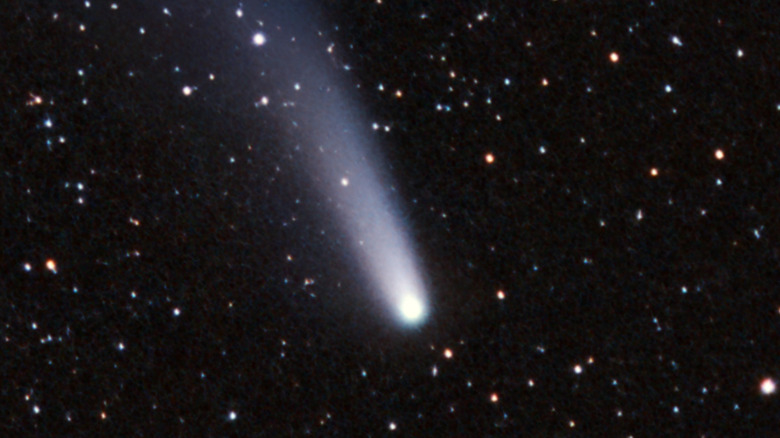Halley's Comet Is Connected With This Christian Symbol
For centuries, the fabled Halley's Comet has traversed the ethereal frontier of space and made its calculated return to earthen skies every 75 years or so. The first recorded sighting of this bedazzling pioneer of the firmament was in 239 B.C. when Chinese astronomers caught a glimpse of it searing through the constellatory map, according to Space. However, other accounts attribute the comet's first sighting to the Greeks in 466 B.C. At any rate, the magnificent phenomenon of Halley's Comet has become a spectacle of mystery and wonder as astronomers and other space lovers continue to track its eternal pilgrimage through our vast solar system. The last time it was visible to the naked human eye was in 1986, and it's not expected to return until approximately 2061.
Halley's Comet is aptly named after Edmund Halley, the British astronomer who first presented the idea that it was a single comet that befuddled observers were seeing every 75 years. He applied Sir Isaac Newton's groundbreaking laws of gravitational push and pull amongst the planets to arrive at his point, and though he didn't live to see the comet return in 1758, scientists and astronomers memorialized his discovery by attaching his name to the celestial object (via Interesting Engineering). However, you might not know that Halley's Comet actually has Biblical significance as well, as Forbes reports.
The Star of Bethlehem could have been Halley's Comet
It isn't unusual to see certain agents of the natural world mirrored in Biblical texts. To that point, many experts believe that the enchanting Star of Bethlehem under which the Three Wise Men rode while on their way to welcome Jesus Christ into the world was in fact inspired by Halley's Comet (of course, it wouldn't inherit that name for many, many years). According to Forbes, the star that the three travelers in the story saw in the eastern sky wasn't actually a star at all, but a comet. Halley's Comet, therefore, could very well have featured in the story of Jesus's birth, and presented itself as a stunning object of the Heavens that The Bible says was a portent of Christ's coming into the world.
Matthew 2:2 reads, "There came wise men from the east to Jerusalem, Saying, Where is he that is born King of the Jews? for we have seen his star in the east, and are come to worship him" (per Bible Hub). Some say that the wise men referred to in the passage could have actually been astronomers scanning the starry night with watchful eyes. In any case, Biblical tales are sometimes difficult to interpret, and ascertaining exactly what certain elements within them represent is a matter of much speculation.
Other theories of what The Star of Bethlehem could be
While the most likely candidate for the true Star of Bethlehem is Halley's Comet, there are other theories that could factor into the allegorical inspiration behind the story's general context. Apparently, it's also not unlikely that the alleged "star" observed looming over the eastern territories outside of Jerusalem could have been Venus as well. As the sun rises, Venus can be seen incandescently pulsating against the wide tapestry of dark sky. Its heliacal trajectory as it appears to "rise" could easily have been mistaken for a star, though astronomers at the time could still accurately identify it as a planet (per Forbes). Having said that, The Star of Bethlehem certainly sounds better than The Planet of Bethlehem, doesn't it?
Others claim that The Star of Bethlehem beheld by The Three Wise Men in the story could also have been a nova or supernova, according to Forbes. This occurs when a star explodes and creates a massive burst of light that seems to be suspended in space and time (via Space Place). It's really something to behold, and it's worth keeping an eye out for if you're somebody who loves gazing up at the galactic landscape.


